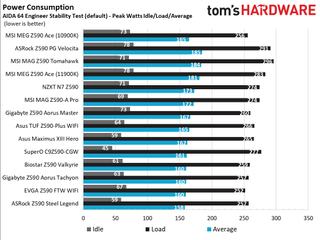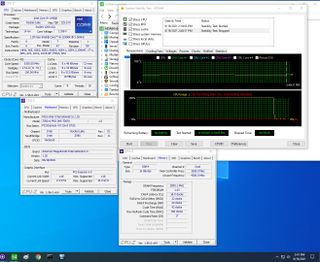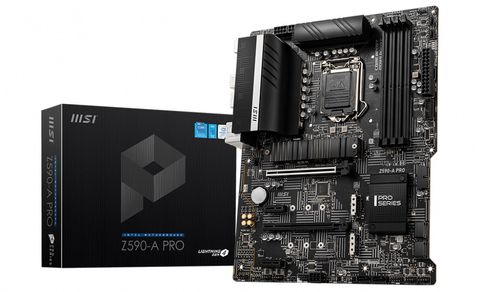Why you can trust Tom's Hardware
Benchmark Results
Our standard benchmarks and power tests are performed using the CPU’s stock frequencies (including stock Thermal Velocity Boost), with all power-saving features enabled. Optimized defaults are set in the BIOS and the memory set using the XMP profiles. For this baseline testing, Windows is set to the balanced power plan.
Synthetic Benchmarks
Synthetics are a great tool to determine if a board runs out of spec, as identical settings should produce similar performance results. Advanced memory timings are the one place where motherboard makers can still optimize for either stability or performance, though, and those settings can impact some testing.





















Overall here, we find a spread of results, depending on the test. For example, our more real-world benchmarks were a bit slower. The 7Zip compression results were below average, along with Cinebench and POVRay. However, performance in the PCMark suite was above average almost across the board -- a good showing there. Memory bandwidth results in AIDA also floated around the middle of our results. In the end, we didn’t see anything alarming from our synthetic benchmarks, though it seems this board isn’t as loose with the Intel specification as others.
Timed Applications




LAME testing showed the Z590-A Pro as one of the faster results at 11.32 seconds. Corona results were spot on average among the competing tested boards, along with both Handbrake tests. There’s nothing to worry about here.
3D Games and 3DMark




We’ve recently updated our game tests to F1 2020 and Far Cry: New Dawn. The games are run at 1920x1080 resolution using the Ultra preset. As the resolution goes up, the CPU tends to have less of an impact. The goal with these settings is to determine if there are differences in performance at the most commonly used resolution with settings most people use or at least strive for.
In 3DMark Fire Strike, the 16,096 points scored place it on the lower half of average just above the SuperO and Biostar boards, but the difference between this group is 200 points or around 1% (run variance). The Time Spy score was also on the lower side of average. But here again, the difference between results is less than 2%, so you’re looking at very little difference from worst to first.
Moving on to games, the Far Cry: New Dawn result was above average, reaching 146 FPS. F1 2020 results were on the faster side at 210 FPS. But here again, the difference between the quickest and slowest (using our Rocket Lake processor) was only around 2.5%. In the end, the Z590-A Pro proves itself a capable gaming board.
Power Consumption / VRM Temperatures

We used AIDA64’s System Stability Test with Stress CPU, FPU and Cache enabled for power testing, using the peak power consumption value. With Rocket Lake, we needed to disable AVX-512 instruction sets. Otherwise, temperatures are out of control at stock speeds on some boards. The wattage reading is from the wall via a Kill-A-Watt meter to capture the entire ecosystem. The only variable that changes is the motherboard; all other parts are the same.
On the power consumption side, the A Pro was right around average at 172W (the average with this dataset is 170W). While idle, the system used around 69W (spot-on average), while the load wattage reached 274W and was barely above average (271W). This isn’t the most efficient board we’ve tested, but you’d be hard-pressed to notice any differences in your electric bill if you opted for this model.




MSI’s 55A VRM configuration worked well overall, managing our Intel Core i9-11900K CPU at both stock speeds and while overclocked. The VRM peaked at just over 50 degrees Celsius when running at stock speeds, which is a middling result compared to other comparable boards. While overclocked to 5.1 GHz, the A Pro peaked at around 58 degrees Celsius. In short, you shouldn’t have any issues overclocking if you’re running with ambient cooling.
Overclocking
Overclocking on the A Pro was straightforward, at least in terms of getting things set up. We set voltages, disabled and TVB boost(s), and any Adaptive boost, so the clocks hold and are unaffected by these automated features. Most overclocking options were found easily in the OC section, though some power options are found in different sub-sections. In the end, reaching 5.1 GHz on our i9-11900K was a breeze.
When overclocking the Core i9-11900K, we decided to do so by testing without AVX-512 instructions. When you unlock all of the power limits, you’re thermally limited, with the CPU reaching 100 degrees Celsius in several seconds. We’ve removed that variable since every board is different in following (or not following) Intel specifications. The bottom line is that if you need to use these instructions, you’ll need to set a significant offset compared to non-AVX-512 loads. To that end, we settled on a 5.1 GHz overclock at around 1.3V. Our CPU uses around 225W in this configuration, which lands between stock power use (195W) and AVX-512 power use (~265W) and is the end of the line due to thermal constraints.

On the memory side of things, the experience was painless. The DDR4 3600 kit dropped in nicely and ran at a 1:1 ratio out of the gate. And our DDR4 4000 sticks worked by simply applying XMP as well. Bandwidth results in AIDA were as expected, so there’s nothing out of the ordinary here.
Final Thoughts
The MSI MAG Z590-A Pro reminds us that you don’t need to spend $400 to get something decent that works well enough both out of the box and with some overclocking on Z590. While a few low-end boards may not pass that litmus test, our MSI MAG Z590-A Pro does. It includes three M.2 sockets, a USB 3.2 Gen 2x2 Type-C port, capable power delivery, and 2.5 GbE for under $200. While it isn’t perfect, there’s a lot to like about this board.
Performance was around the average, with our more real-world tests running slower than synthetics. But there were no major outliers. It overclocked without worry and handled both kits of memory, so you can squeeze everything your hardware has out of the A Pro -- so long as you stick to ambient cooling methods. Some minor tweaking is required if you want to get the most out of the board at stock speeds, but nothing major.
Ideally, I’d like to see somewhat better aesthetics. For me, the lined/checkerboard-like pattern is just too busy and makes the board look cheaper than it is. That said, there’s no RGB lighting on board, so it’s not like the MSI MAG Z590-A Pro is begging for attention, and it still fits within most build themes. I’d also like to see a better audio codec, something from the Realtek ALC1200 series, instead of the older ALC897. Last, with how hot some of these PCIe-based M.2 modules run, I’d prefer to see heatsinks on all available sockets. But again, if you’re shopping for a cheap Z590 motherboard, it’s unlikely you’re going to be running three super-fast M.2 drives.

Competition in the budget space is fierce, as each major partner has a board priced similarly. Asus has the Prime Z590-P WIFI ($199.99), Gigabyte’s Z590 UD ($189.99) and the ASRock Z590 Steel Legend ($214.99) also fall on either side in terms of price. All these boards have three M.2 slots, but only the ASRock and MSI have six SATA ports, with some port sharing. They all include 2.5 GbE, but the Asus is the only one that includes Wi-Fi. They all use the same budget audio Realtek audio codec, so there’s no escaping that without a new sound card or external DAC. Without major feature or price differences, things come down to appearance, Wi-Fi (or not), and if you need a USB 3.2 Gen 2x2 Type-C port (only the Asus and MSI have that). Regardless, the Z590-A Pro holds up well against its peers.
Overall, the MSI MAG Z590-A Pro is a solid budget-class motherboard. Performance in some tests was a bit lower compared to others, but it excelled in games and the PCMark 10 Suite. For under $200, MSI delivers a well-rounded motherboard that includes enough features to satisfy most mainstream Z590 system needs. If you’re looking to get into the Z590 platform on the cheap, the Z590-A Pro and the A-Pro Wi-Fi model should be on your shortlist.
MORE: Best Motherboards
MORE: How To Choose A Motherboard
MORE: All Motherboard Content

Joe Shields is a Freelance writer for Tom’s Hardware US. He reviews motherboards.
